A BARTHOLOMEW PURDY SCENARIO COVERING PUBLIC RECORD ENTRIES:
SASH MAKER/MEMORIALIST, LAMP LIGHTERS SUPERINTENDENT, STREET REPAIR COMMISSIONER, CIVIL WAR VET, ASSEMBLY CANDIDATE, KEEPER
The line-of-duty nature of NYC Keeper Purdy’s death was the chief focus of NJ DOC Major Wayne Sanderson’s dogged research as well as the focal point of his excellent summary of the research results (above) , written especially for this NY Correction History web site and its Facebook extension.
In contrast, the follow-up research by the NY Correction History webmaster/Facebook admin has concentrated on the public life and times of Keeper Purdy.
XXX

 XXX
XXX |
|
Click either above image to access House of Representatives Journal page noting the names of those mechanics and artisans who signed the petition in favor of the Bank of the U.S. retaining its charter. | | While the following scenario fits the facts from that research, it is not the only scenario which could be woven from those facts. Rather this interpretation is offered provisionally as the one seeming most plausible to this researcher. But it remains open to revision if further facts come to light that require undertaking reinterpretation.
The first of the public record events which this version attributes to Purdy well before he became a keeper involves 21-year-old Bartholomew joining other “mechanics and artisans in the City of New York” petitioning Congress Feb. 10, 1834, against its returning the U.S. to a “metallic currency.”
Signed by hundreds whose crafts “embrace . . . all the mechanical arts incident to a populous city,” their petition (called in that era a Memorial) declared they had “discarded all feeling . . . .of party prejudice” in concluding that the cause of financial disruptions then adversely impacting them was the general uncertainty whether the charter of the prevailing paper currency’s bulwark, Bank of the United States, would be renewed. The reference to “party prejudice” was recognition that President Jackson’s attack on the Bank had become a party-line issue.
Bartholomew B. Purdy had signed the Memorial as “sash maker,” a noble mechanical calling in an era when most folks lacked access to any air conditioning other than opening the windows.
XXX

XXX |
|
The above death notice is among the images which NJ Corrections Major Wayne Sanderson shared with the New York Correction History group on Facebook and the CorrectionHistory.Org web site. | | Keep in mind that 41 years later the death notice for Bartholomew B. Purdy included a reference to mechanics organized in a memorial activity of a kind entirely different than petitioning Congress. The newspaper notice announcing his death “suddenly on March 29,” 1875 declared that “relatives and friends of the family, also the members of Marion Council, No. 53, O. U. A. M. and sister councils, are cordially invited to attend the funeral, from his late residence, No. 2336 Third Ave., on Thursday, April 1, at one o'clock p.m.”
Those initials stand for Order of United American Mechanics, a fraternal/insurance benefits organization which began in the mid-1840s with strong Nativist views. When precisely Purdy joined the OUAM is not known but it is interesting to note that Benjamin appears in the annual lists of NYC officials in the mid-1840s. In that same period, Nativist sentiments in NYC reached its heights, electing James Harper as mayor. Such sentiments were not exclusive to his Nativist Party.
XXX
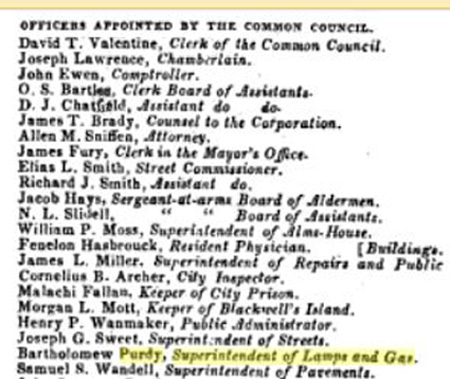
XXX |
|
The above image, reflecting Bartholomew Purdy's continued Common Council appointment as Lamps and Gas Superintendent during the mayoralty of Tammany's Andrew H. Mickle, was extracted from a larger image in the New York State Register 1845 Page 90. Click to access. Scroll from Page 90 to Page 89 to see Mickle's name. | | Harper was defeated for re-election by Tammany Hall-backed William F. Havemeyer, during whose first term Bartholomew Purdy was appointed by the Common Council as Superintendent of Lamps and Gas.
According to NYC’s Bylaws and Ordinances then in force, the lamp and gas superintendent had charge of the municipality’s street lamp lighters and was responsible for securing and maintaining the supplies and equipment by which the lamps were lit. He also supervised conversion of street lighting from oil to gas.
Mayor Havemeyer reputedly was not compliant enough to suite the Tammany bosses. So instead of nominating him for re-election, they put forward another candidate more to their liking: Andrew H. Mickle, who won in the mayoralty in the spring of 1846. Purdy continued as lamps and gas superintendent, again by Common Council appointment.
Another election later that same year involved congressional contests and saw allegations made that inmates and patients from Public Charities and Correction agency’s penitentiary and almshouse were illegally deployed to increase the Democratic vote in certain districts.
XXX

XXX |
|
Click above excerpts image for a 3-page PDF featuring the full text of the grand jury presentment alleging election illegalities involving Blackwell Island penitentiary inmates and naming but not indicting Street Lamps Superintendent Benjamin Purdy. Keep in mind that Special Justice of the Peace Henry W. Merritt and Alderman Egbert Benson, initiators of these charges against Tammany pols, keepers and policemen were both Whigs. Note also that both Tammany and the Whigs regularly accused each of precisely these same kinds of election illegalities, depending which party had control over the Blackwell facilities and which had the power of prosecution. Some years earlier Whig Justice Merritt had himself been the target of prosecution suspected of having been politically inspired. That case ended in dismissal of all charges. For more details on that, see History of the Court of Common Pleas of the City and County of New York by James Wilton Brooks Pages 37 - 43. | | Superintendent Purdy’s name surfaced during the post-election probes into the allegations.
Purportedly Purdy had used his position as a public official to have a certain police officer get the election eve off. The imputed reason: so that the officer could, in effect, baby-sit through the night a bunch of prematurely-released penitentiary inmates (freed before fully serving their sentences). The off-duty officer was to make sure they voted the next morning, presumably as told.
The grand jury did not include Purdy among those indicted but its presentment strongly urged that he be discharged from public office. However, the Common Council appeared in no hurry to remove Purdy. In fact, his removal some months later -- Tuesday, May 11th, 1847 to be precise -- was not specifically related to that case. It was the result of the transition from an old city administration to a new one, a transition that included a make-over of the Council itself and therefore an across-the-board replacement of virtually all its appointees. [See Organization of New City Council in the relevant May 1847 issue of the NY Tribune.]
XXX
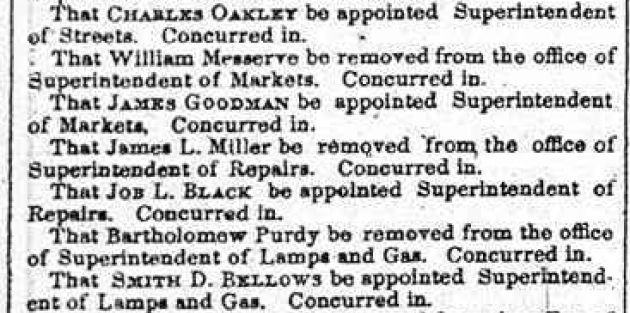
XXX |
|
In the image above, the entry for the removal of Bartholomew Purdy as the Common Council's appointed Superintendent of Lamps and Gas appears as the second from the bottom in the list. But actually the image is of a very small section of a vastly longer list of removals and replacements reflecting reorganization of city government in the wake of the Whig victory over Tammany in the prior election. Click to access. Give the full newspaper page PDF from the very excellent fultonhistory.org site time to load. | | Purdy’s departure coincided with the May 11, 1847 installation of Whig Mayor William V. Brady who had defeated rival mayoral candidates, Tammany Hall Democrat J. Sherman Brownell and the Nativist American Ellis G. Drake who, in effect, helped pull Democrat votes away from Brownell.
Purdy’s 1847 removal from high-profile office due to changes in the political pecking order at City Hall did not constitute life-long banishment from NYC municipal government. A half-decade later, Purdy was elected as Commissioner of Repairs and Supplies in balloting which also elected Tammany-backed Jacob Westervelt as mayor.
According to a NYC Charter amendment then in force, the Commissioner of Repairs and Supplies headed the mayoral agency overseeing all repairs to roads, pavements, public buildings and fire department apparatus and supplying of supplies for same.
XXX
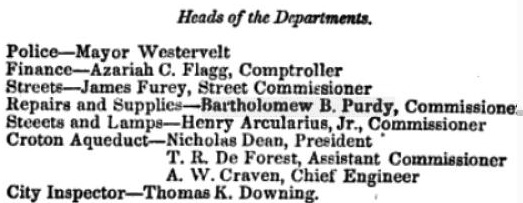
XXX |
|
The above image is from one of a number of sources listing Bartholomew B. Purdy as the elected Commissioner of Street Repairs and Supplies. This one is from Livingston's Law Register of the period. Click to access. The reason that the Mayor is listed as heading police was a new law which made him, in effect, its chief civilian executive. Policemen had been resisting his efforts to put them into uniforms. | | In late 1854, Tammany boss and Tweed precursor, Fernando Wood, was elected mayor, succeeding Westervelt. Purdy was re-elected Commissioner of Repairs and Supplies.
Wood and Purdy belonged to opposing factions of Tammany. The mayor belonged to the so-called Soft Shell faction which favored accepting back into the Democratic Party power structure those who had bolted in key previous elections. Purdy belonged the Hard Shells who opposed restoring the renegades to party power.
The NYC government in 1855, elected in November of the previous year, mostly consisted of Tammany Democrats from both factions. One newspaper listed the line-up thusly:
Mayor, Fernando Wood - Soft;
XXX

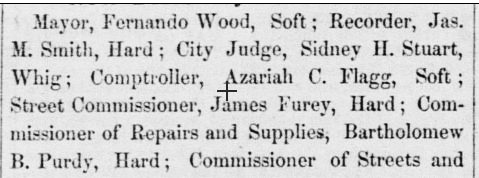 XXX
XXX |
|
The images above are from parts of a long Dec. 9, 1854, the Sacramento Daily Union story about the returns of the NY election held the previous month. Other newspapers, copies of which perhaps had been delivered in the regular postal service mail or by special arrangement with ship captains, were cited as its sources, a practice still quite common in the era even as telegraph news wire services began taking hold in certain areas. Click either image to access the relevant page on the California Digital Newspaper Collection site. | |
Recorder - Jas. M. Smith - Hard;
City Judge - Sidney Stuart, Whig;
Comptroller - Azariah C. Flagg, Soft;
Street Commissioner - James Furey, Hard;
Commissioner of Repairs and Supplies - Bartholomew B. Purdy, Hard;
Commissioner of Streets and Lamps - Jos. E. Ebling, Know Nothing;
City Inspector - Thos. R. Downing, Soft.
In the fall of 1855, District Attorney A. Oakey Hall (at that point a Whig in his long political career of various party labels) unveiled corruption indictments against about a dozen city officials, including councilmen, aldermen, and commissioners, among whom was Bartholomew B. Purdy, Commissioner of Repairs and Supplies.
XXX
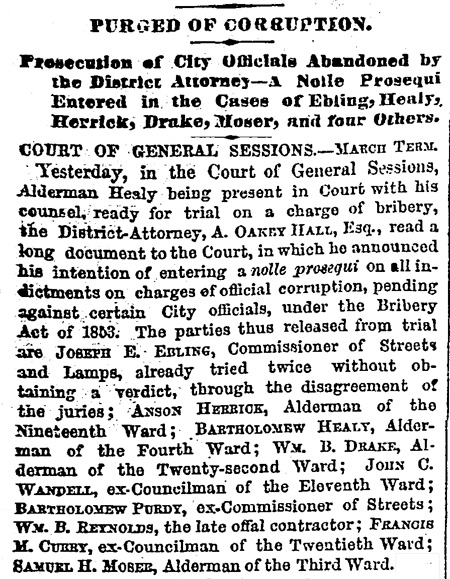
XXX |
|
The headlines and part of the first paragraph of a long NYT story appearing March 14, 1856. Click to access. | | However, seven months later, after three trials (not against Purdy) ended in acquittals or hung-juries, DA Hall on March 14, 1856, went before the Court of General Session and asked for permission to drop all the cases.He contended each was dependent upon similar accomplice testimony whose corroboration apparently had failed to unanimously satisfy juries in the trials already held and appeared unlikely to satisfy future juries unanimously if the remaining cases proceeded to trial.
Careful not to apply the principle to any particular case tried, Hall offered the general observation that trying public officials presents special challenges because of concerns some jurors may be influenced by partisan loyalties.
The court granted the DA’s nolle presequi motion. Thus, Bartholomew B. Purdy’s name appeared on the list of nine defendants for whom the newspaper headlines read “Purged of Corruption” charges. However, by then Purdy was no longer an elected Commissioner in the city government.
On-line research next finds record of him during the Civil War enrolling with the New York 158th Infantry Regiment in Brooklyn on August 31, 1862, being commissioned as a 1st Lieutenant the following Nov. 10, and as a Captain Jan. 10, 1863.
XXX
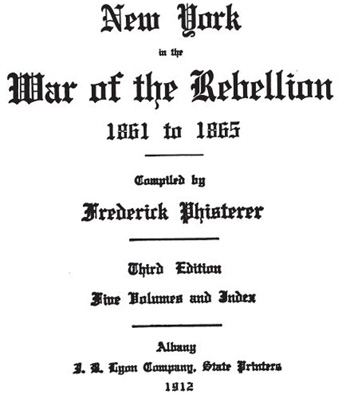
XXX |
|
Above is a composite image of the title page of Colonel and Congressional Medal of Honor recipient Frederick Phisterer's New York in the War of the Rebellion 1861 to 1865. All the printed elements of the page are preserved; only the white spaces separating them have been compressed. | |
XXX

XXX |
|
Click the above image to access its source, page 3854 of Volume 5, Third Edition, of Frederick Phisterer's monumental work, New York in the War of the Rebellion 1861 to 1865. published in 1912 and incorporated into the Documents of the Assembly that same year. | | Known as the Empire Brigade, the
158th saw action in North Carolina and Virginia, including Appomattox Court House. It lost 134 men, including two officers.
Capt. Purdy was with the regiment at Bogue Inlet, N. C. , March 31, 1864, when his youngest daughter, Elizabeth, 13, died in NYC. For this reason, the funeral was held from the residence of her uncle, James R. McGregor, Esq. [See NYT April 2, 1864 death notice.]
The captain mustered out with his 158th Company K at Richmond, Va., June 30, 1865, about two months after Lee’s surrender in the town of Appomattox Court House.
A half dozen years later, the 58-year-old former infantry captain/ex-city commissioner made a stab at restarting his political career. He entered the November, 1871 race for state Assemblyman as an Independent Democrat in the 21st A.D. but drew only 130 votes out of 8,879 cast in the three-man contest. [See Charles Purdom Baril's The Evening Journal Almanac (Volume 1871) Page 29. ]
XXX

 "
XXX "
XXX |
|
Click either above image to access City Record entry of Bartholomew B. Purdy's 1873 appointment at the 5th District prison. | | Despite his poor showing, Purdy may still have had friends in Tammany who perhaps arranged for him in 1873 to be sworn as a 5th District Jail deputy keeper with a $1,000 annual salary.
Evaluating the All-in-One
B B. Purdy Scenario
Of course, the above scenario about the sash maker/memorialist, the lamp lighters superintendent, the street repairs commissioner, the Civil War captain, and the Assemblyman candidate hinges on the premise that they were all one and the same Bartholomew B. Purdy, the 5th District Jail Deputy Keeper.
In assessing the reasonableness of that premise, let's start with the Civil War veteran. The entry for him in the very excellent web resource, Find A Grave, makes no mention of his being a jail keeper nor of any his other NYC government employments.
XXX
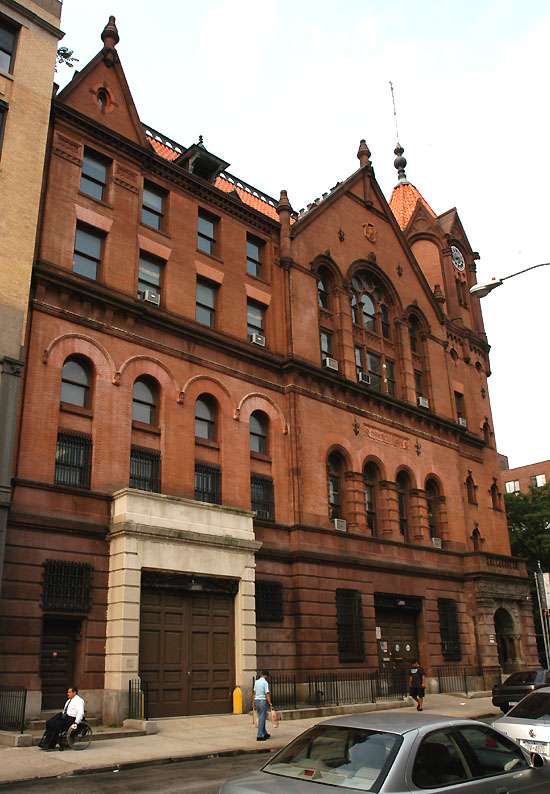
XXX |
|
The Harlem Jail on 126th St. where Keeper Purdy had his fatal heart attack in 1875 should not be confused with the 121st St. Harlem Court/Jail complex built and opened in the early 1890s. The latter structure's court section has been restored and is used for civil proceedings. The complex's attached multi-tiered jail structure, not used for inmate incarceration since 1949, features 40 double-bunk cells designed for holding up to 80 prisoners. In contrast, landmark preservation documents and reports of New York Protestant Episcopal City Mission Society chaplains indicate that the earlier jail, situated near, if not attached to the 12th Precinct Station/police court (which was located at 146-148 East 126th Street) was a very small facility described as on 126th St. near Lexington and 4th Avenues. Click image for virtual tour of the restored 121st St. Harlem Courthouse and its un-restored and unused multi-tiered jail structure.
| | But it goes into some detail about his Civil War record. We know he is "our" Bartholomew B. Purdy because the date of death matches the keeper's (March 29, 1875) and because the year (1813) given for his birth fits with the newspaper reports that the jailer was 62 when he suffered his fatal heart attack.
An objection could be made that the age (45) given in Phisterer's bio entry for Lt./Capt.Purdy is about four years younger than ought be the case for someone born in 1813. Bartholomew B.'s birth year would have made his age 49 or so when he enlisted in 1862. But it was not uncommon during the Civil War for those seeking to enlist to tack on or shave off a few years in order to improve their chances of being accepted into a volunteer regiment being organized. The age Bartholomew B. gave for himself still made him one of the two oldest Lieutenants in the 158th. The other "old man" also had given his age as 45.
Next, let's consider Bartholomew B. the sash maker/memorialist. Again, working with 1813 as the year-of-birth, we note that he was at the traditional "age of majority" -- 21 -- when he signed the petition. Today the so-called legal age in most states for most legal requirements and qualifications is 18. But, back in the 19th Century, organizers of the New York City mechanics and artisans' petition to Congress would have sought signatures from men 21 years and older in those fields. Also at this point, he had been a year without his father as the head of the family; thus he was more his own man. According to Find A Grave, his father, who also had Bartholomew as his Christian name, died in 1833.
XXX
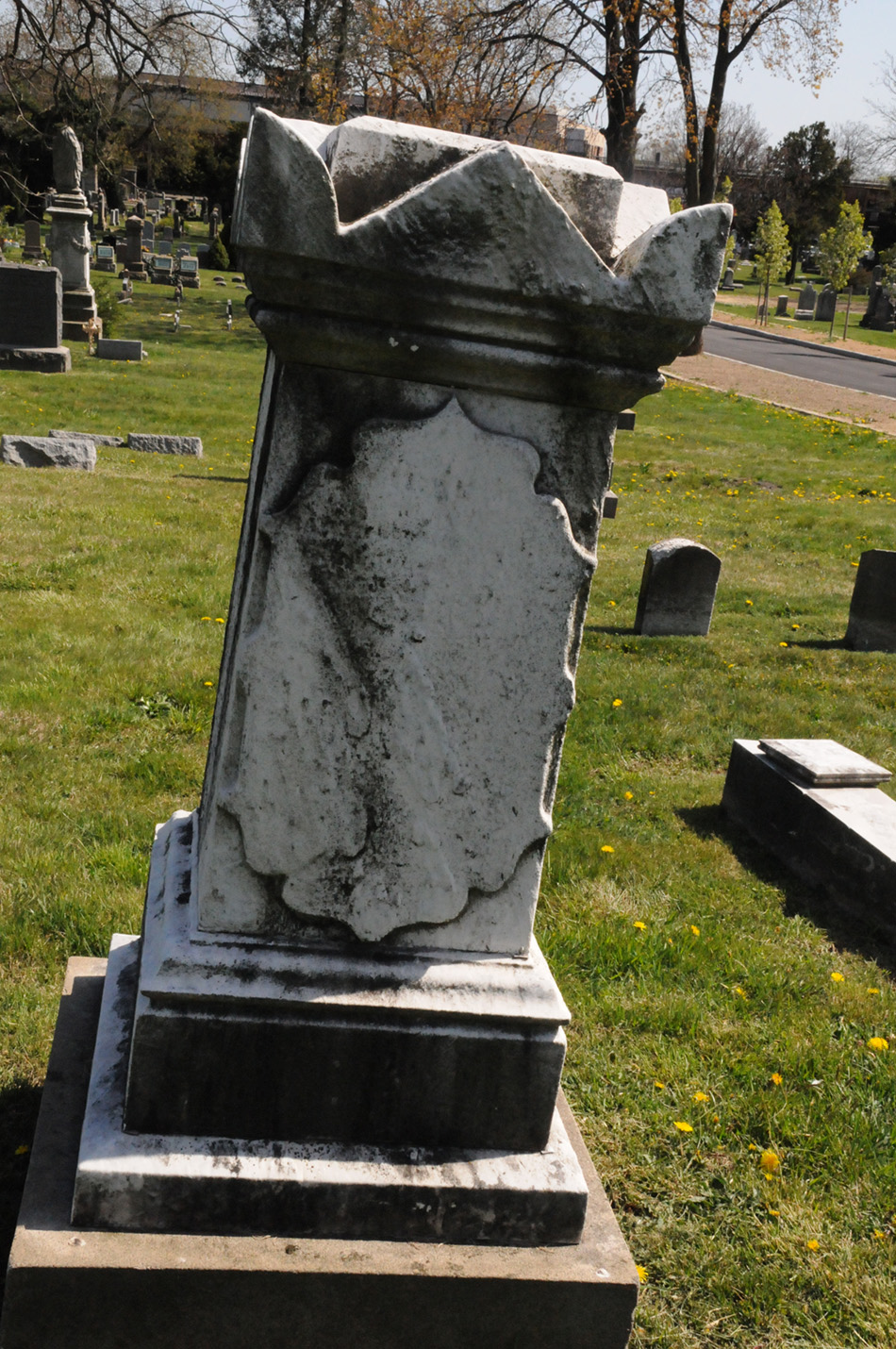
XXX |
|
The monument in Cypress Hills Cemetery for Bartholomew B. and Sarah Ann (Springsted) Purdy's daughter Blanche H, (Purdy) Cassidy ( Sep. 24, 1873-- Dec. 18, 1905. Her father and mother's also are buried in Cypress Hills Cemetery. Click image from Find-A-Grave web site for more information and images. | | Four years later, sash maker Bartholomew B., married a young teenager, Sarah M. Ryerson. But after 25 years of marriage, she died of a heart failure on June 1, 1862. Only two months later the widowed Purdy joined the 158th Regiment, leaving their offspring in the care of relatives. What employment, financial, and/or emotional circumstances prompted him to take that step is not known.
We do know that his second wife (who interestingly had the same first name as his first wife) was 21 years younger than he. Born in 1834, Sarah Ann Springsted wed Bartholomew B. Purdy in February 1869 when she was 35 and he was 56. About four years later she bore him a daughter, Blanche H. Some 14 years and one marriage earlier, she bore her first husband, Henry Isaac Acken, a daughter, Henrietta Elizabeth Acken, who in due time became Blanche's half-sister. Henry died in Rockland County in late 1862.
Next in our evaluation of the stated scenario, let us recognize that it treats the Lamp Lighters Superintendent Bartholomew Purdy and Street Repairs Commissioner Bartholomew B. Purdy as the same person, even though the references to Superintendent found on-line do not include the middle initial B whereas the references found on-line for the Commissioner, the sash maker, the failed Assembly candidate and the Prison Keeper all do.
I would argue that the B-inclusive Purdy references increase, not decrease the likelihood that the B-less Purdy references refer to the same individual. That there were two different Bartholomew Purdys involved in Tammany politics, named in grand jury presentments separated by years, and held city government posts which related to maintaining and upgrading street conditions seems less likely than that there was only one.
XXX
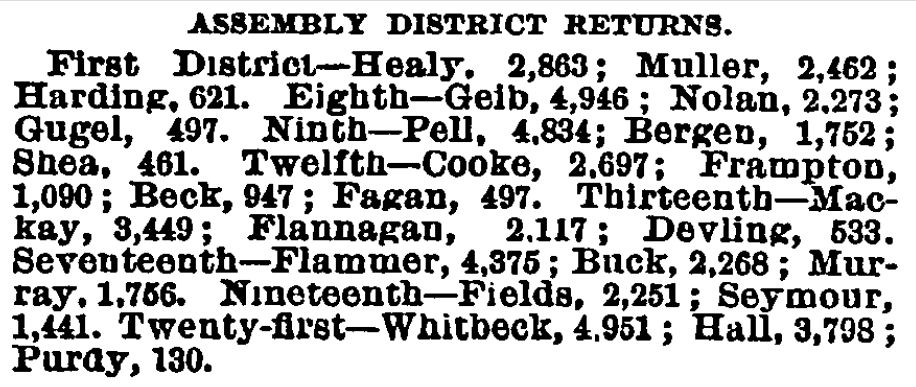
XXX |
|
The last entry in the above image from a newspaper report on the November 1871 NYC Assembly election returns shows how poorly Purdy did. From Charles Purdom Baril's The Evening Journal Almanac, cited higher up in the main text, we know Purdy ran as an Independent Democrat; John M. Hall, as a Tammany Democrat, and the winner, William A. Whitbeck, as a Republican. President of the West Side Association of Taxpayers, the Assemblyman died the following June at age 47. The NYT had Purdy's tally as 135. | | Not that our one and only Bartholomew Purdy was the sole Purdy having some degree of public visibility in municipal government at the time. Indeed, having a far higher public profile in that era was Elijah Fisher Purdy. The various offices he held at different times included Alderman, President of the County Board of Supervisors, Surrogate, Emigration Commissioner, President of the Board of Alderman, and Acting Mayor. He also was a Tammany Grand Sachem (a top boss). Both Elijah and Bartholomew came from Purdy family lines with ties to Westchester. Did they know each other and, if so, did the elder and more well-connected Purdy help the junior Purdy in his career?
But not long after the Civil War ended and Bartholomew had returned to NYC, Elijah died at age 70 (Jan. 8th, 1866). Perhaps because ex-Captain Purdy's Tammany patron was gone, he tried a run as an Independent Democrat for an Assembly seat but failed poorly. Did someone among his former Tammany and City Hall buddies feel concern for how the veteran pol was going provide from himself and his new wife, a widow young enough to have been his daughter, and she having a daughter of her own? The post of night keeper at the small Harlem jail did not pay much by Tammany/City Hall standards. But the modest salary was respectable and much needed, especially a couple of years later when daughter Blanche was born. He was then 60 and would have only two years to be father to the little girl whom strangers might mistake as his grandchild.
Even if our preferred scenario turns out to have holes and bumps not easily traversed, it serves -- initially at least -- to sketch some of the background of the era to which Keeper Purdy and his checkered life and career belonged.
|
